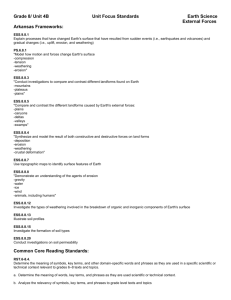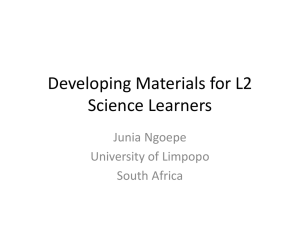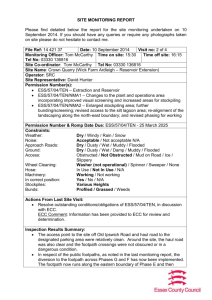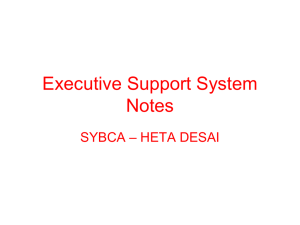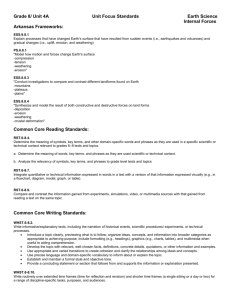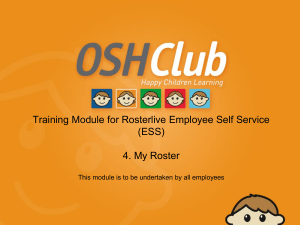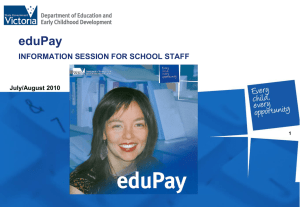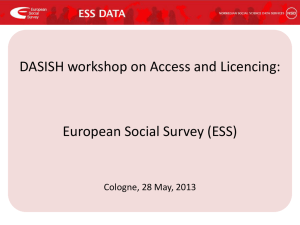ESS Framework & Indicators for SRPs
advertisement
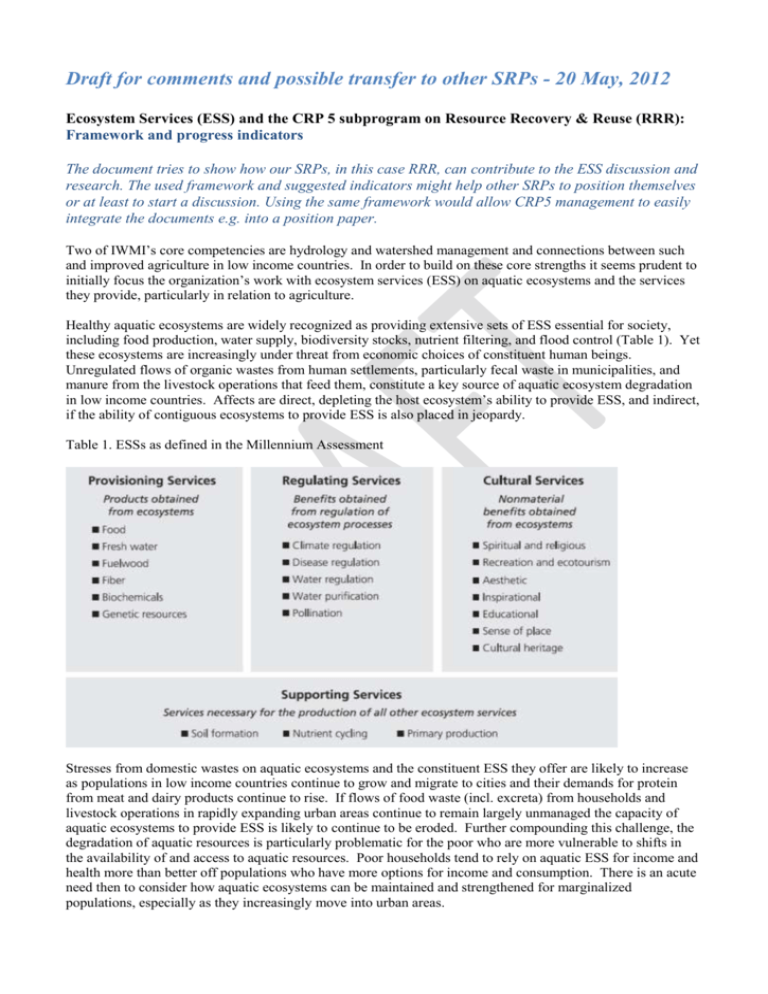
Draft for comments and possible transfer to other SRPs - 20 May, 2012 Ecosystem Services (ESS) and the CRP 5 subprogram on Resource Recovery & Reuse (RRR): Framework and progress indicators The document tries to show how our SRPs, in this case RRR, can contribute to the ESS discussion and research. The used framework and suggested indicators might help other SRPs to position themselves or at least to start a discussion. Using the same framework would allow CRP5 management to easily integrate the documents e.g. into a position paper. Two of IWMI’s core competencies are hydrology and watershed management and connections between such and improved agriculture in low income countries. In order to build on these core strengths it seems prudent to initially focus the organization’s work with ecosystem services (ESS) on aquatic ecosystems and the services they provide, particularly in relation to agriculture. Healthy aquatic ecosystems are widely recognized as providing extensive sets of ESS essential for society, including food production, water supply, biodiversity stocks, nutrient filtering, and flood control (Table 1). Yet these ecosystems are increasingly under threat from economic choices of constituent human beings. Unregulated flows of organic wastes from human settlements, particularly fecal waste in municipalities, and manure from the livestock operations that feed them, constitute a key source of aquatic ecosystem degradation in low income countries. Affects are direct, depleting the host ecosystem’s ability to provide ESS, and indirect, if the ability of contiguous ecosystems to provide ESS is also placed in jeopardy. Table 1. ESSs as defined in the Millennium Assessment Stresses from domestic wastes on aquatic ecosystems and the constituent ESS they offer are likely to increase as populations in low income countries continue to grow and migrate to cities and their demands for protein from meat and dairy products continue to rise. If flows of food waste (incl. excreta) from households and livestock operations in rapidly expanding urban areas continue to remain largely unmanaged the capacity of aquatic ecosystems to provide ESS is likely to continue to be eroded. Further compounding this challenge, the degradation of aquatic resources is particularly problematic for the poor who are more vulnerable to shifts in the availability of and access to aquatic resources. Poor households tend to rely on aquatic ESS for income and health more than better off populations who have more options for income and consumption. There is an acute need then to consider how aquatic ecosystems can be maintained and strengthened for marginalized populations, especially as they increasingly move into urban areas. Prospects exist to reverse degradation of aquatic ecosystems caused in particular by organic wastes resulting from human patterns of consumption and waste generation incl. defecation and for human action to instead strengthen ESS. Entrepreneurial initiatives in the public and private sector are illustrating that increasing concentrations of organic wastes in low income countries do not have to result in degradation of these ecosystems and can, through recycling and reuse, be harnessed to improve, rather than deplete, constituent ESS. Entrepreneurial activity in organic resource recycling and reuse (RRR) focuses around developing business approaches along two RRR pathways: (1) harnessing the nutrient and water content in waste resources and directing it for agriculture uses; and (2) drying organic wastes or tapping wet wastes for methane, and converting it into energy. The latter conversion process can also yield organic fertilizer. These approaches - if sustainable - show how organic wastes can be valuable resources that, in the case of nutrients and water, augment food production; and, in the case of conversion to energy, limit pollution while generating a critical infrastructure service in the form of heat or electricity. Through these approaches even defecation by humans and animals is converted to a resource that improves the stocks of ESS that can support well-being, instead of degrading them. These approaches show that negative trade-offs between increases in organic wastes and ESS do not have to be the norm. Biogas generation from waste is not only reducing the need to tap into fossil energy, but also preventing the emission of methane from decomposing waste which contributes 21 times stronger to climate change than carbon dioxide. The key challenge is however to makes these processes viable and sustainable. Fortunately, the number of entrepreneurs pursuing novel approaches in RRR is growing and the development of these new models is certainly not business as usual. The Resource Recovery & Reuse (RRR-CRP5) team is strongly supporting this development by bridging between the agricultural and sanitation sectors, and by fostering business perspectives in a domain so far dominated by engineering. Following the framework of the Millennium Assessment (MA), the CRP5 work on RRR supports (see Figure 1) direct (1) and indirect (2) drivers of ecosystem change (pollution control, change of resource consumption, science & technology and economic incentives) as well as the well-being of humans by providing health and food (3). This can be achieved by targeting improved nutrient and water cycling and water purification (supporting and regulatory ESS) which directly influence disease transmission and (Figure 1). Figure 1: RRR support for ESSs displayed via the ESS Framework of the MA (see blue X). Work at scale in these new approaches will require further investments in learning, knowledge, know-how and capital by public and private actors. To help chart the direction for this work, the RRR team is identifying, analyzing, documenting, and then modeling how internal and external factors come together to allow pioneer innovative entrepreneurial activities in organic waste conversion to nutrients and energy succeed. The research is beginning to reveal how both public and private capital and entrepreneurial initiative can be tapped to sustain the conversion of organic wastes into productive assets and hints at how it can strengthen/expand the possibility of ESS from aquatic ecosystems by augmenting the quantity of nutrients and water accessible for agricultural production and by converting pollutants that degrade ESS into an energy resource yielding economic benefits. While the current research is a good start, further research is necessary. At least five areas of research are critical to enhance the viability of the related processes at scale in relation to the interplay between innovative approaches to RRR in relation to ESS, particularly to aquatic ecosystems: (1) investigate more fully interactions between contexts and processes taking place in entrepreneurial waste recovery and reuse enterprises and model such; (2) understand how these entrepreneurial processes support ESS and ultimately benefit livelihoods; (3) engage with local stakeholders to discuss (1) and (2) and then to; (4) think through how to configure approaches that maximize benefits of associated ESS to low income, marginalized populations; and (5) explore how the public and private sector can work together to facilitate sustained growth of these enterprises and associated fortification of ESS. In order to measure the impact of such research, new indicators are necessary. This is a new area of work and indicators are not standard. Below are some suggestions on short- and medium-term indicators to start the discussion, selected in line with the MA. Long-term indicators would eventually circle around the percentages of otherwise wasted nutrients recovered, environmental health and e.g. DALYs averted. Short -term indicators 1. Evidence of involvement of local stakeholders in the process of thinking through interactions between entrepreneurial activities in RRR and ESS and possible benefits to livelihoods 2. Evidence of increased awareness among stakeholders of possible win-win interactions between entrepreneurial activities in RRR and ESS 3. Evidence of increased awareness of how entrepreneurial approaches in RRR can maximize benefits of associated ESS to low income, marginalized populations 4. Number of models for entrepreneurial RRR documented and linked to ESS approaches 5. Number of mechanisms designed to leverage investment in subject approaches 6. Number of policy measures designed to leverage development of subject approaches 7. Number of associations designed and formed to represent subject businesses Medium-term Indicators 1. Uptake of entrepreneurial RRR approaches linked to ESS by interested public or private sector actors 2. Investment in subject approaches by public or private financial institutions 3. Adoption by governments of policy measure to leverage development of subject approaches 4. Level subject entrepreneurial approaches strengthen ESS and promote ecosystem functioning in the medium term 5. Level to which subject approaches: (a.) reduce market distortions, (b.) align incentives; and (c.) internalize costs and benefits to promote the strengthening of ESS in the target ecosystems 6. Level of local stakeholder involvement in decision-making in relation subject approaches, including breadth and depth of knowledge considered in formulating RRR ESS 7. Effects of subject approaches on adjacent and other ecosystems 8. Adaptability of subject entrepreneurial approaches to change In sum, human interactions involvement in ESS is dynamic; we are part of and depend on ESS for survival and at the same time play a vital role in their maintenance and/or degradation. New entrepreneurial approaches that leverage private and public capital to support RRR of organic waste are essential component in maintenance of aquatic ecosystems and the ESS they provide in low income countries. If economic choices undermine these ESS, potential short-term economic gains come at a loss of valuable ecosystem functions which could potentially benefit more people and, if not managed correctly, could adversely affect the health of the ecosystem, and possibly those contiguous to it, and lead to a decline in livelihood options and well-being. Entrepreneurial approaches to RRR that positively influence nutrient flows or reduce critical pollutants by generating services like energy that support economic growth can be critical to maximize economic and social welfare. The challenge is to support the growth of these entrepreneurial initiatives in a manner where benefits accrue equitably without compromising vital ecosystem functions and the ESS they offer.
